Peugeot 3008 Hybrid 4 2013 Owner's Manual - RHD (UK. Australia)
Manufacturer: PEUGEOT, Model Year: 2013, Model line: 3008 Hybrid 4, Model: Peugeot 3008 Hybrid 4 2013Pages: 340, PDF Size: 16.51 MB
Page 131 of 340
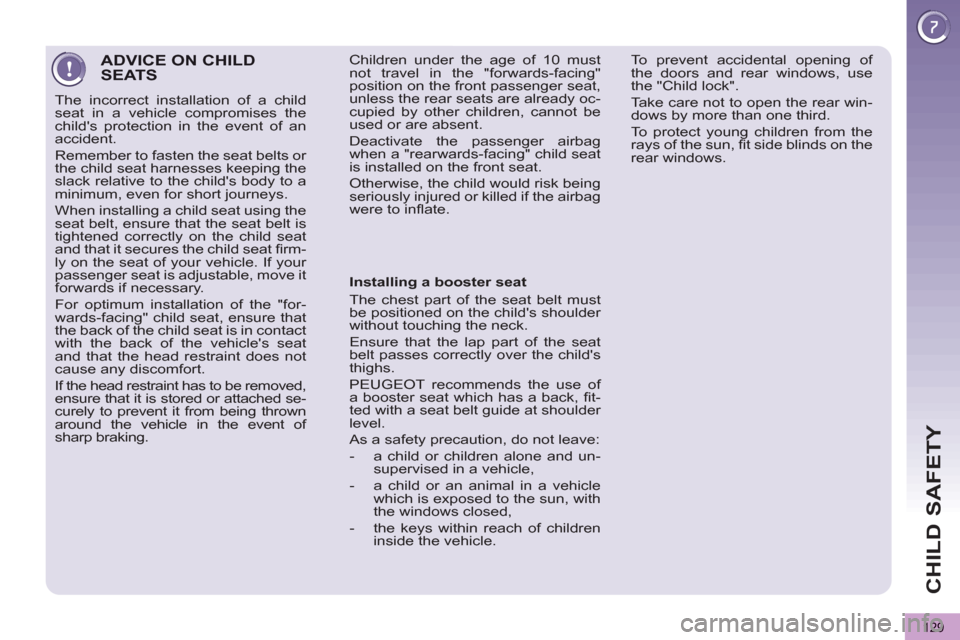
CHILD SAFETY
129
ADVICE ON CHILDSEATS
The incorrect installation of a child
seat in a vehicle compromises the
child's protection in the event of an
accident.
Remember to fasten the seat belts or
the child seat harnesses keeping the
slack relative to the child's body to a
minimum, even for short journeys.
When installing a child seat using the
seat belt, ensure that the seat belt is
tightened correctly on the child seat
and that it secures the child seat fi rm-
ly on the seat of your vehicle. If your
passenger seat is adjustable, move it
forwards if necessary.
For optimum installation of the "for-
wards-facing" child seat, ensure that
the back of the child seat is in contact
with the back of the vehicle's seat
and that the head restraint does not
cause any discomfort.
If the head restraint has to be removed,
ensure that it is stored or attached se-
curely to prevent it from being thrown
around the vehicle in the event of
sharp braking.
Installing a booster seat
The chest part of the seat belt must
be positioned on the child's shoulder
without touching the neck.
Ensure that the lap part of the seat
belt passes correctly over the child's
thighs.
PEUGEOT recommends the use of
a booster seat which has a back, fi t-
ted with a seat belt guide at shoulder
level.
As a safety precaution, do not leave:
- a child or children alone and un-
supervised in a vehicle,
- a child or an animal in a vehicle
which is exposed to the sun, with
the windows closed,
- the keys within reach of children
inside the vehicle. To prevent accidental opening of
the doors and rear windows, use
the "Child lock".
Take care not to open the rear win-
dows by more than one third.
To protect young children from the
rays of the sun, fi t side blinds on the
rear windows.
Children under the age of 10 must
not travel in the "forwards-facing"
position on the front passenger seat,
unless the rear seats are already oc-
cupied by other children, cannot be
used or are absent.
Deactivate the passenger airbag
when a "rearwards-facing" child seat
is installed on the front seat.
Otherwise, the child would risk being
seriously injured or killed if the airbag
were to infl ate.
Page 132 of 340
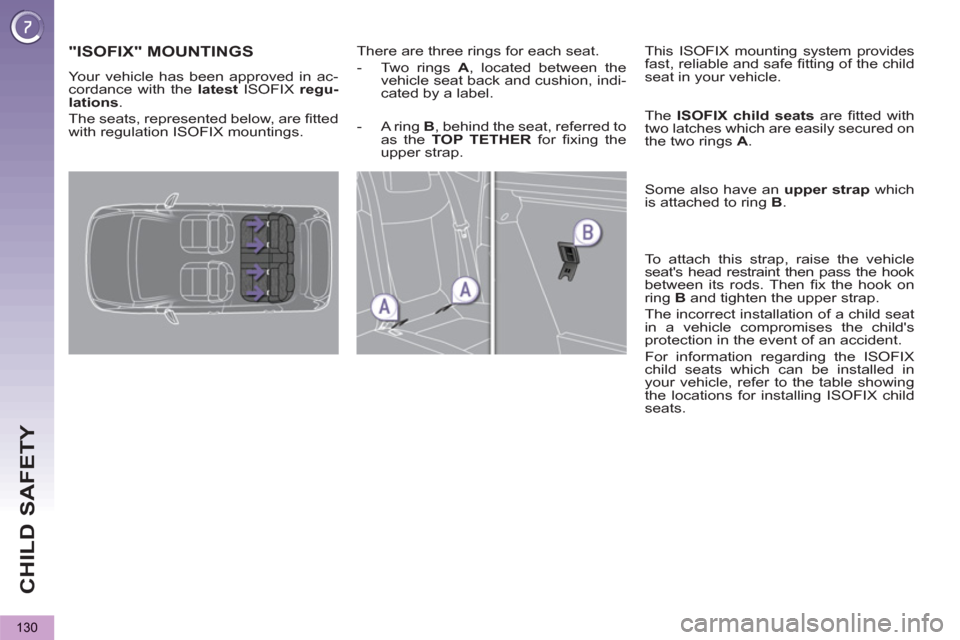
CHILD SAFETY
130
"ISOFIX" MOUNTINGS
There are three rings for each seat.
- Two rings A
, located between the
vehicle seat back and cushion, indi-
cated by a label.
This ISOFIX mounting system provides
fast, reliable and safe fi tting of the child
seat in your vehicle.
The ISOFIX child seats
are fi tted with
two latches which are easily secured on
the two rings A
.
Some also have an upper strap
which
is attached to ring B
.
To attach this strap, raise the vehicle
seat's head restraint then pass the hook
between its rods. Then fi x the hook on
ring B
and tighten the upper strap.
The incorrect installation of a child seat
in a vehicle compromises the child's
protection in the event of an accident.
For information regarding the ISOFIX
child seats which can be installed in
your vehicle, refer to the table showing
the locations for installing ISOFIX child
seats.
Your vehicle has been approved in ac-
cordance with the latest
ISOFIX regu-
lation
s
.
The seats, represented below, are fi tted
with regulation ISOFIX mountings.
- A ring B
, behind the seat, referred to
as the TOP TETHER
for fi xing the
upper strap.
Page 133 of 340
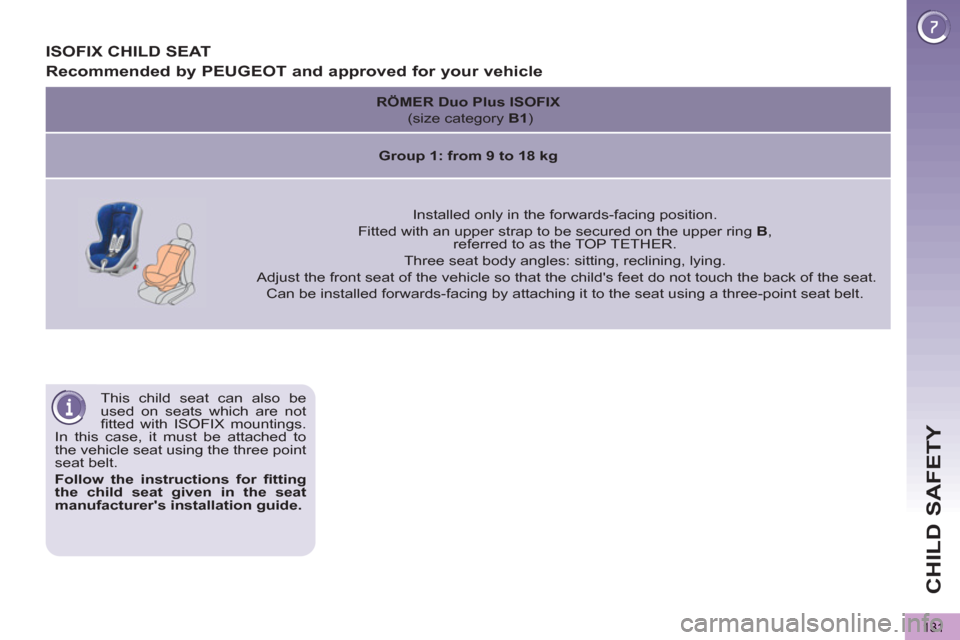
CHILD SAFETY
131
This child seat can also be
used on seats which are not
fi tted with ISOFIX mountings.
In this case, it must be attached to
the vehicle seat using the three point
seat belt.
Follow the instructions for fi tting
the child seat given in the seat
manufacturer's installation guide.
ISOFIX CHILD SEAT
Recommended by PEUGEOT and approved for your vehicle
RÖMER
Duo Plus ISOFIX
(size category B1
)
Group 1: from 9 to 18 kg
Installed only in the forwards-facing position.
Fitted with an upper strap to be secured on the upper ring B
,
referred to as the TOP TETHER.
Three seat body angles: sitting, reclining, lying.
Adjust the front seat of the vehicle so that the child's feet do not touch the back of the seat.
Can be installed forwards-facing by attaching it to the seat using a three-point seat belt
.
Page 134 of 340
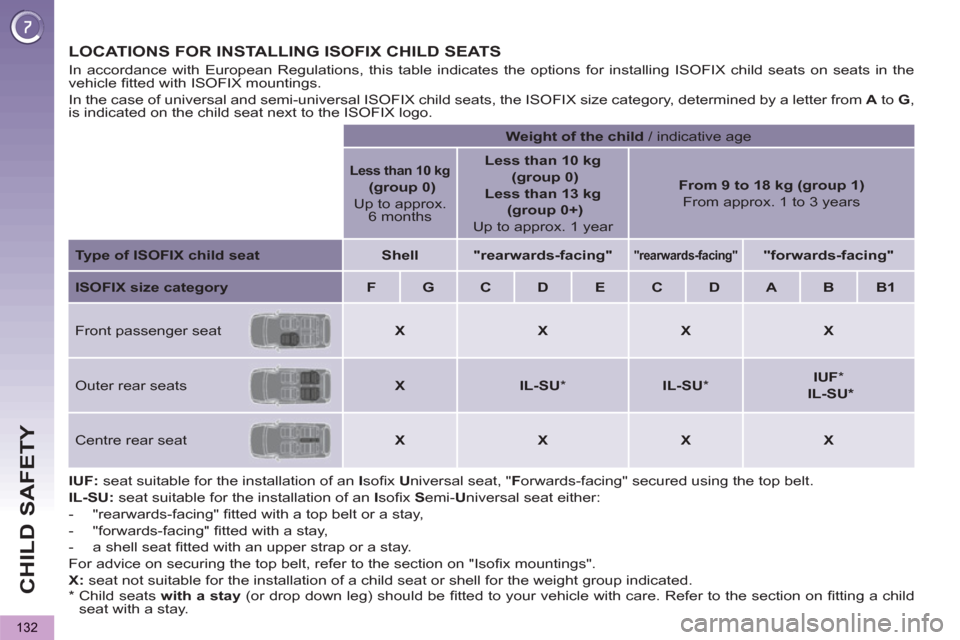
CHILD SAFETY
132
LOCATIONS FOR INSTALLING ISOFIX CHILD SEATS
*
Child seats with a
stay
(or drop down leg) should be fi tted to your vehicle with care. Refer to the section on fi tting a child
seat with a stay.
In accordance with European Regulations, this table indicates the options for installing ISOFIX child seats on seats in the
vehicle fi tted with ISOFIX mountings.
In the case of universal and semi-universal ISOFIX child seats, the ISOFIX size category, determined by a letter from A
to G
,
is indicated on the child seat next to the ISOFIX logo.
Weight of the child
/ indicative age
Less than 10 kg
(group 0)
Up to approx.
6 months
Less than 10 kg
(group 0)
Less than 13 kg
(group 0+)
Up to approx. 1 year
From 9 to 18 kg (group 1)
From approx. 1 to 3 years
Type of ISOFIX child seat
Shell
"rearwards-facing"
"rearwards-facing"
"forwards-facing"
ISOFIX size category
F
G
C
D
E
C
D
A
B
B1
Front passenger seat
X
X
X
X
Outer rear seats
X
IL-SU
*
IL-SU
*
IUF
*
IL-SU *
Centre rear seat
X
X
X
X
IUF:
seat suitable for the installation of an I
sofi x U
niversal seat, " F
orwards-facing" secured using the top belt.
IL-SU:
seat suitable for the installation of an I
sofi x S
emi- U
niversal seat either:
- "rearwards-facing" fi tted with a top belt or a stay,
- "forwards-facing" fi
tted with a stay,
- a shell seat fi tted with an upper strap or a stay.
For advice on securing the top belt, refer to the section on "Isofi x mountings".
X:
seat not suitable for the installation of a child seat or shell for the weight group indicated.
Page 135 of 340
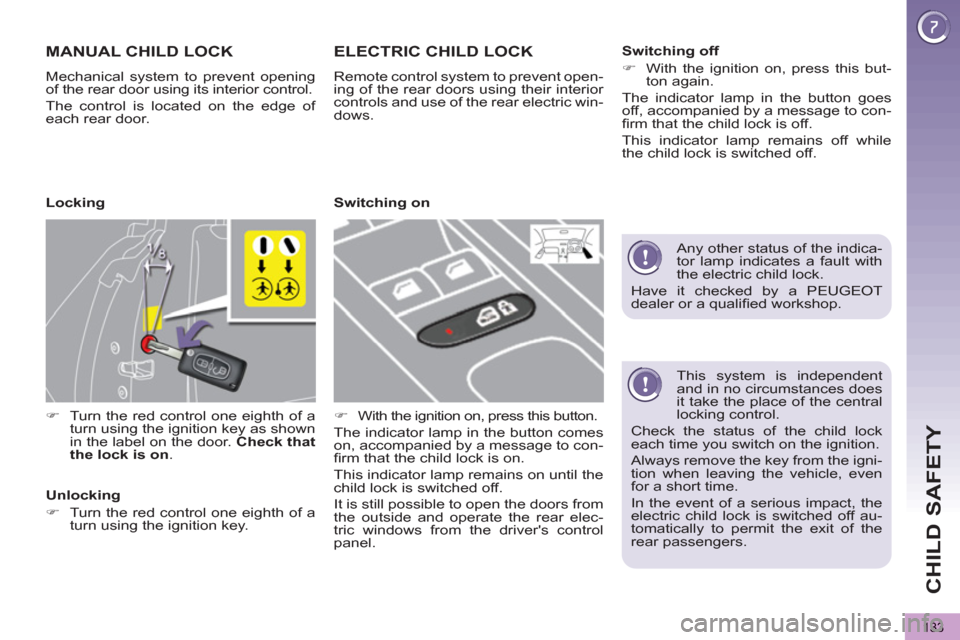
CHILD SAFETY
133
This system is independent
and in no circumstances does
it take the place of the central
locking control.
Check the status of the child lock
each time you switch on the ignition.
Always remove the key from the igni-
tion when leaving the vehicle, even
for a short time.
In the event of a serious impact, the
electric child lock is switched off au-
tomatically to permit the exit of the
rear passengers.
MANUAL CHILD LOCK
Mechanical system to prevent opening
of the rear door using its interior control.
The control is located on the edge of
each rear door.
�)
Turn the red control one eighth of a
turn using the ignition key as shown
in the label on the door. Check that
the lock is on
.
ELECTRIC CHILD LOCK
Remote control system to prevent open-
ing of the rear doors using their interior
controls and use of the rear electric win-
dows.
�)
With the ignition on, press this button.
The indicator lamp in the button comes
on, accompanied by a message to con-
fi rm that the child lock is on.
This indicator lamp remains on until the
child lock is switched off.
It is still possible to open the doors from
the outside and operate the rear elec-
tric windows from the driver's control
panel.
Locking
Unlocking
�)
Turn the red control one eighth of a
turn using the ignition key.
Switching on
Switching off
�)
With the ignition on, press this but-
ton again.
The indicator lamp in the button goes
off, accompanied by a message to con-
fi rm that the child lock is off.
This indicator lamp remains off while
the child lock is switched off.
Any other status of the indica-
tor lamp indicates a fault with
the electric child lock.
Have it checked by a PEUGEOT
dealer or a qualifi ed workshop.
Page 136 of 340
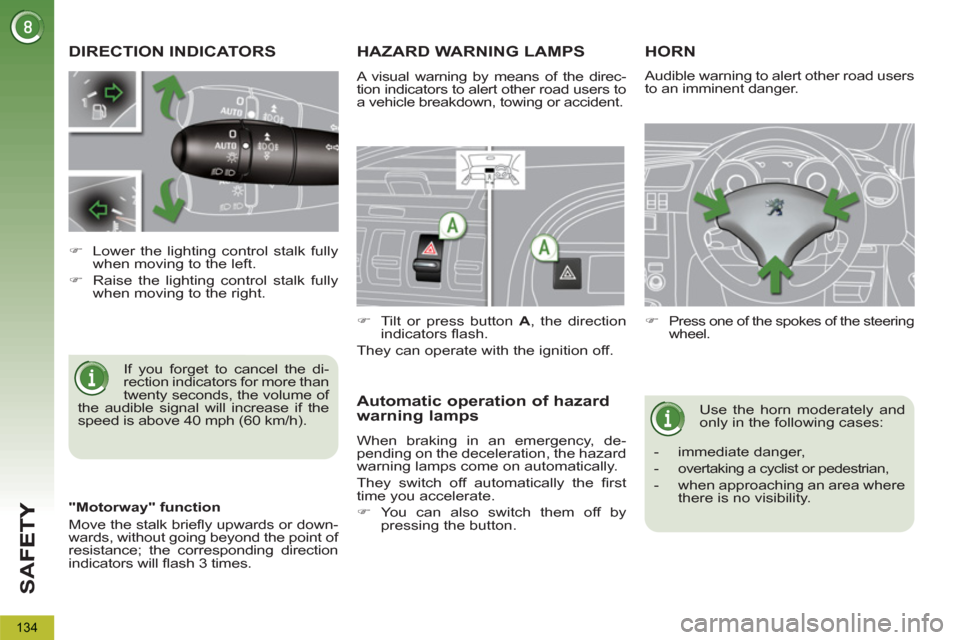
SA
F
134
DIRECTION INDICATORS
If you forget to cancel the di-
rection indicators for more than
twenty seconds, the volume of
the audible signal will increase if the
speed is above 40 mph (60 km/h).
�)
Lower the lighting control stalk fully
when moving to the left.
�)
Raise the lighting control stalk fully
when moving to the right.
HAZARD WARNING LAMPS
A visual warning by means of the direc-
tion indicators to alert other road users to
a vehicle breakdown, towing or accident.
�)
Tilt or press button A
, the direction
indicators fl ash.
They can operate with the ignition off.
Automatic operation of hazard
warning lamps
When braking in an emergency, de-
pending on the deceleration, the hazard
warning lamps come on automatically.
They switch off automatically the fi rst
time you accelerate.
�)
You can also switch them off by
pressing the button.
HORN
�)
Press one of the spokes of the steering
wheel.
Use the horn moderately and
only in the following cases:
- immediate danger,
- overtaking a cyclist or pedestrian,
- when approaching an area where
there is no visibility.
Audible warning to alert other road users
to an imminent danger.
"Motorway" function
Move the stalk briefl y upwards or down-
wards, without going beyond the point of
resistance; the corresponding direction
indicators will fl ash 3 times.
Page 137 of 340
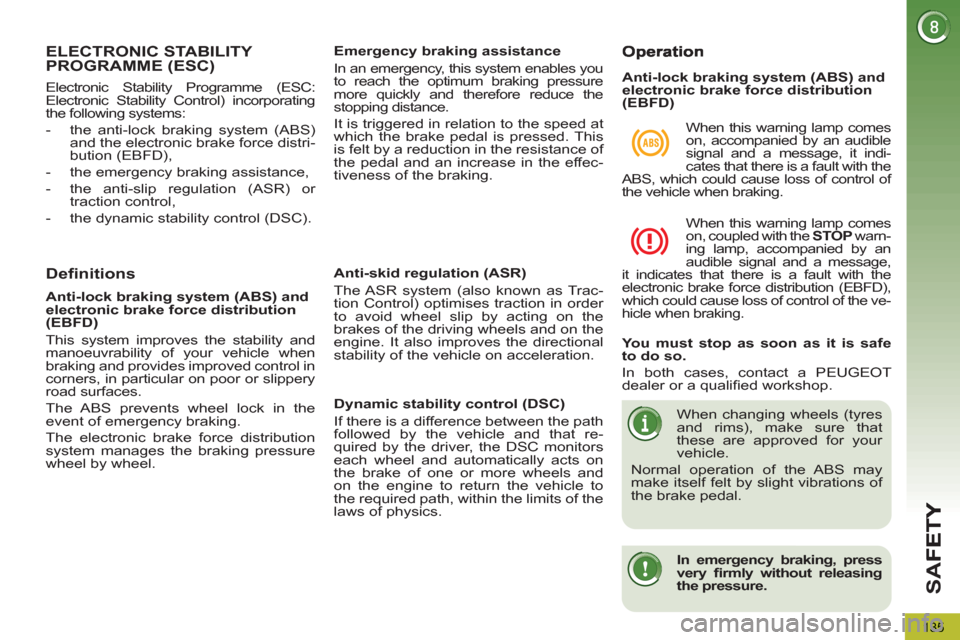
SA
F
135
ELECTRONIC STABILITY PROGRAMME (ESC)
Definitions
Anti-skid regulation (ASR)
The ASR system (also known as Trac-
tion Control) optimises traction in order
to avoid wheel slip by acting on the
brakes of the driving wheels and on the
engine. It also improves the directional
stability of the vehicle on acceleration.
Dynamic stability control (DSC)
If there is a difference between the path
followed by the vehicle and that re-
quired by the driver, the DSC monitors
each wheel and automatically acts on
the brake of one or more wheels and
on the engine to return the vehicle to
the required path, within the limits of the
laws of physics.
Emergency braking assistance
In an emergency, this system enables you
to reach the optimum braking pressure
more quickly and therefore reduce the
stopping distance.
It is triggered in relation to the speed at
which the brake pedal is pressed. This
is felt by a reduction in the resistance of
the pedal and an increase in the effec-
tiveness of the braking.
Anti-lock braking system (ABS) and
electronic brake force distribution
(EBFD)
This system improves the stability and
manoeuvrability of your vehicle when
braking and provides improved control in
corners, in particular on poor or slippery
road surfaces.
The ABS prevents wheel lock in the
event of emergency braking.
The electronic brake force distribution
system manages the braking pressure
wheel by wheel.
When this warning lamp comes
on, accompanied by an audible
signal and a message, it indi-
cates that there is a fault with the
ABS, which could cause loss of control of
the vehicle when braking.
When this warning lamp comes
on, coupled with the STOP
warn-
ing lamp, accompanied by an
audible signal and a message,
it indicates that there is a fault with the
electronic brake force distribution (EBFD),
which could cause loss of control of the ve-
hicle when braking.
You must stop as soon as it is safe
to do so.
In both cases, contact a PEUGEOT
dealer or a qualifi ed workshop.
When changing wheels (tyres
and rims), make sure that
these are approved for your
vehicle.
Normal operation of the ABS may
make itself felt by slight vibrations of
the brake pedal.
In emergency braking, press
very fi rmly without releasing
the pressure.
Anti-lock braking system (ABS) and
electronic brake force distribution
(EBFD)
Electronic Stability Programme (ESC:
Electronic Stability Control) incorporating
the following systems:
- the anti-lock braking system (ABS)
and the electronic brake force distri-
bution (EBFD),
- the emergency braking assistance,
- the anti-slip regulation (ASR) or
traction control,
- the dynamic stability control (DSC).
Page 138 of 340
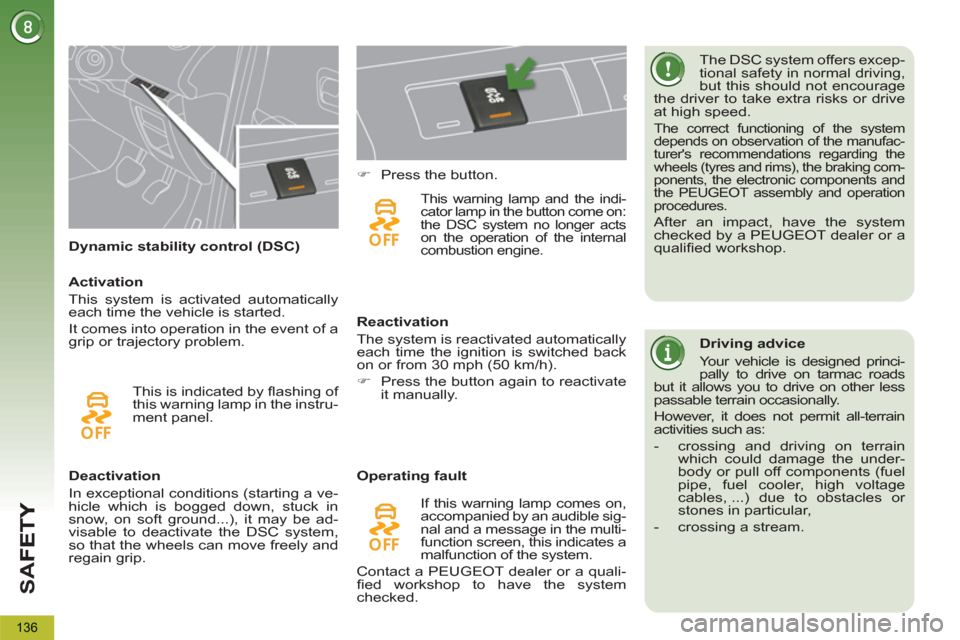
SA
F
136
Dynamic stability control (DSC) The DSC system offers excep-
tional safety in normal driving,
but this should not encourage
the driver to take extra risks or drive
at high speed.
The correct functioning of the system
depends on observation of the manufac-
turer's recommendations regarding the
wheels (tyres and rims), the braking com-
ponents, the electronic components and
the PEUGEOT assembly and operation
procedures.
After an impact, have the system
checked by a PEUGEOT dealer or a
qualifi ed workshop.
Deactivation
In exceptional conditions (starting a ve-
hicle which is bogged down, stuck in
snow, on soft ground...), it may be ad-
visable to deactivate the DSC system,
so that the wheels can move freely and
regain grip.
�)
Press the button.
This warning lamp and the indi-
cator lamp in the button come on:
the DSC system no longer acts
on the operation of the internal
combustion engine.
Reactivation
The system is reactivated automatically
each time the ignition is switched back
on or from 30 mph (50 km/h).
�)
Press the button again to reactivate
it manually.
Operating fault
If this warning lamp comes on,
accompanied by an audible sig-
nal and a message in the multi-
function screen, this indicates a
malfunction of the system.
Contact a PEUGEOT dealer or a quali-
fi ed workshop to have the system
checked. This is indicated by fl ashing of
this warning lamp in the instru-
ment panel.
Activation
This system is activated automatically
each time the vehicle is started.
It comes into operation in the event of a
grip or trajectory problem.
Driving advice
Your vehicle is designed princi-
pally to drive on tarmac roads
but it allows you to drive on other less
passable terrain occasionally.
However, it does not permit all-terrain
activities such as:
- crossing and driving on terrain
which could damage the under-
body or pull off components (fuel
pipe, fuel cooler, high voltage
cables, ...) due to obstacles or
stones in particular,
- crossing a stream.
Page 139 of 340
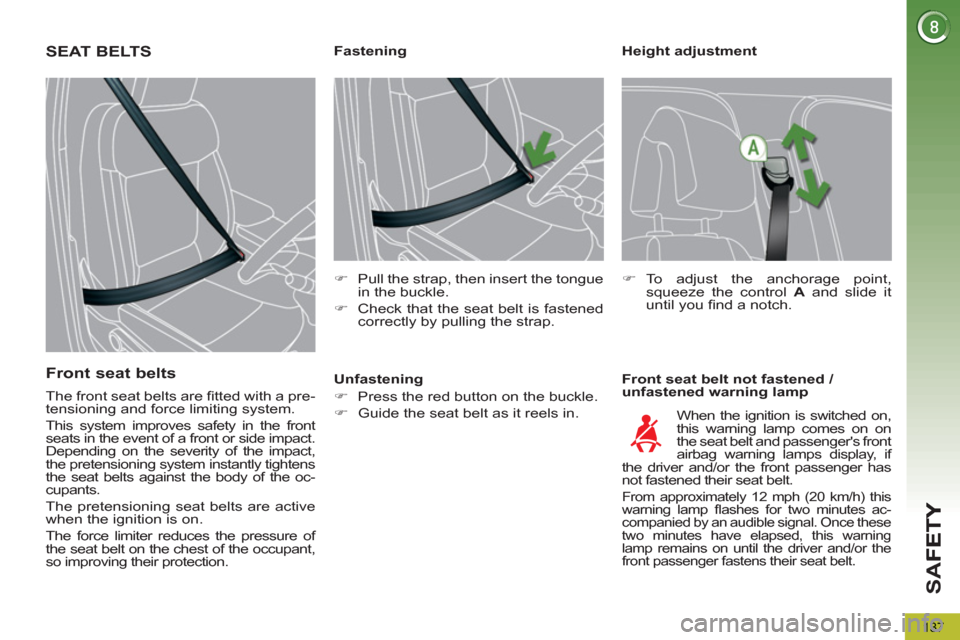
SA
F
137
Height adjustment
Front seat belt not fastened /
unfastened warning lamp
Fastening
�)
Pull the strap, then insert the tongue
in the buckle.
�)
Check that the seat belt is fastened
correctly by pulling the strap.
�)
To adjust the anchorage point,
squeeze the control A
and slide it
until you fi nd a notch.
When the ignition is switched on,
this warning lamp comes on on
the seat belt and passenger's front
airbag warning lamps display, if
the driver and/or the front passenger has
not fastened their seat belt.
From approximately 12 mph (20 km/h) this
warning lamp fl ashes for two minutes ac-
companied by an audible signal. Once these
two minutes have elapsed, this warning
lamp remains on until the driver and/or the
front passenger fastens their seat belt.
Unfastening
�)
Press the red button on the buckle.
�)
Guide the seat belt as it reels in.
SEAT BELTS
Front seat belts
The front seat belts are fi tted with a pre-
tensioning and force limiting system.
This system improves safety in the front
seats in the event of a front or side impact.
Depending on the severity of the impact,
the pretensioning system instantly tightens
the seat belts against the body of the oc-
cupants.
The pretensioning seat belts are active
when the ignition is on.
The force limiter reduces the pressure of
the seat belt on the chest of the occupant,
so improving their protection.
Page 140 of 340
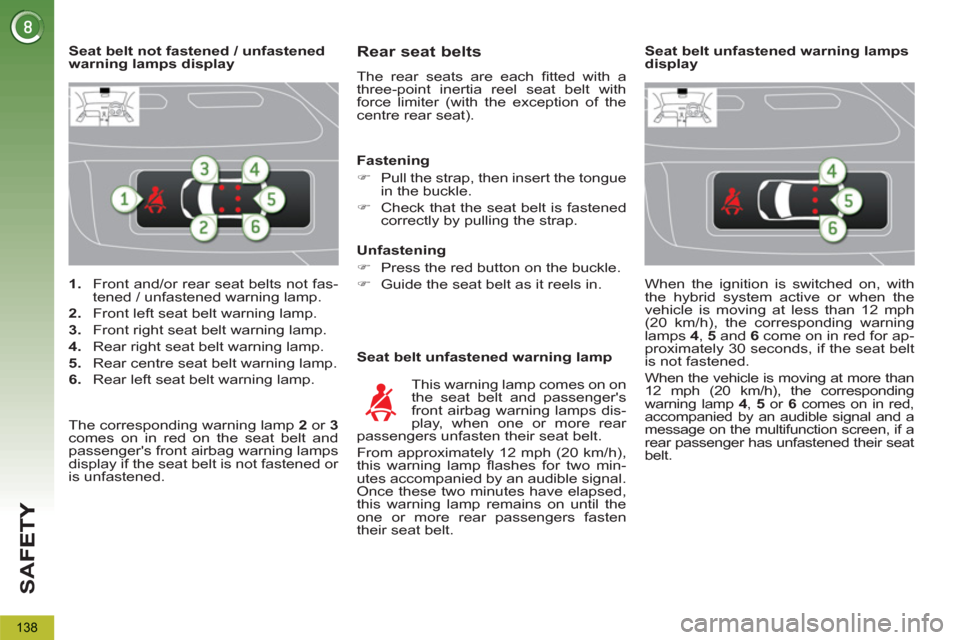
SA
F
138
1.
Front and/or rear seat belts not fas-
tened / unfastened warning lamp.
2.
Front left seat belt warning lamp.
3.
Front right seat belt warning lamp.
4.
Rear right seat belt warning lamp.
5.
Rear centre seat belt warning lamp.
6.
Rear left seat belt warning lamp.
Seat belt not fastened / unfastened
warning lamps display
Rear seat belts
The rear seats are each fi tted with a
three-point inertia reel seat belt with
force limiter (with the exception of the
centre rear seat).
Seat belt unfastened warning lamp
This warning lamp comes on on
the seat belt and passenger's
front airbag warning lamps dis-
play, when one or more rear
passengers unfasten their seat belt.
From approximately 12 mph (20 km/h),
this warning lamp fl ashes for two min-
utes accompanied by an audible signal.
Once these two minutes have elapsed,
this warning lamp remains on until the
one or more rear passengers fasten
their seat belt.
Fastening
�)
Pull the strap, then insert the tongue
in the buckle.
�)
Check that the seat belt is fastened
correctly by pulling the strap.
Unfastening
�)
Press the red button on the buckle.
�)
Guide the seat belt as it reels in.
The corresponding warning lamp 2
or 3
comes on in red on the seat belt and
passenger's front airbag warning lamps
display if the seat belt is not fastened or
is unfastened.
When the ignition is switched on, with
the hybrid system active or when the
vehicle is moving at less than 12 mph
(20 km/h), the corresponding warning
lamps 4
, 5
and 6
come on in red for ap-
proximately 30 seconds, if the seat belt
is not fastened.
When the vehicle is moving at more than
12 mph (20 km/h), the corresponding
warning lamp 4
, 5
or 6
comes on in red,
accompanied by an audible signal and a
message on the multifunction screen, if a
rear passenger has unfastened their seat
belt.
Seat belt unfastened warning lamps
display